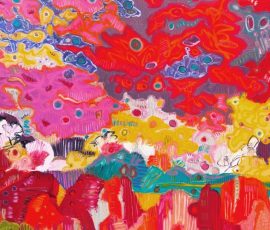Let’s end the confusion and set the record straight. Pronounced “zhee-clay”, it’s a term based on the French verb, gicler (“to squirt”), and was coined by printmaker Jack Duganne in the early 1990s to mean any inkjet-based digital print used as fine art.
Easy, right? Here’s a little more background…
Originally, the term giclée was meant to distinguish industrial pre-press proofs made for matching color from the fine art prints being produced on the same types of printers. Made by Iris Graphics, Inc. (hence the name ‘Iris printer’ or ‘Iris print’), these complex pioneering printers used a sophisticated print head to disperse the ink on the paper in a fine mist (aka ‘ink jet’ printers).

photo: pictexstudio.com
Decades later, today’s giclée prints are created using professional 8 to 12-color ink-jet printers. These printers employ special fade-resistant “archival” inks which will keep their color for up to 25 years if kept out of the sun. The prints can also be produced on any type of paper. Thanks to modern technology, quality is high allowing these extremely detailed images to be marketed as fine art.

photo: angelinasart.com
From the artist’s point of view, giclées are desirable because any number of reproductions can be ordered at any given time and at a relatively low cost. Gone are the days when an artist faced a large outlay of funds resulting in mass produced images. Now with digital printing, once the scan is made and archived, printing is on-demand and affordable. In addition, these digitally scanned images can easily be customized by adjusting size or the material onto which the print is made (i.e., various papers or canvas).
So you ask, “Should I buy one?”
There’s no right answer, it’s a matter of taste. Personally, I prefer owning an original. While I applaud the innovation and appreciate how digital printing is helping us collect fine art more affordably, it is undeniably special to collect art that no one else has. If you are considering a giclée, be discriminating. Find out if the image is from an edition and how many prints are in the edition. Is the image signed by the artist? Do as much research as you can- a source I recommend is The International Fine Print Dealers Association.
When you have the choice, I’d opt for one of a kind. Your art collection will be unique and, most likely, you will have a better investment for having purchased original art.




While your article is fairly accurate as to the history of the term “Giclée”. Your are VERY inaccurate and misleading people as to the Archival Quality and Permanence of images made with today’s advanced Inks and Papers. Even inexpensive Home Printers can achieve Image Permanence Ratings of 150 – 200 years when displayed under glass.
See the following Links to the foremost Authority in Modern Printers, Inks, and Paper testing for Permanence Wilhelm Imaging Research: http://www.wilhelm-research.com/
Here’s a $500 or less Printer from Hewlett Packer that can does perform extremely well when the correct HP inks and papers are used:
http://www.wilhelm-research.com/hp/B8850.html
What you say about “25 years if kept out of sunlight” would apply to inferior low price replacement inks and papers made without regard to any Permanence of the Image being Printed.
Even Museums around the world have Giclées in their permanent collections, MOMA in NY, the Louvre in Paris, to name but a couple.
As a professional Artist, I think Originals are the best for many of the same reasons you stated in your brief article, BUT… the less cost factor lets patrons and collectors purchase “affordable” artworks via the Giclée.
Ah, this strikes a nerve in the photo world. Analog vs digital printing. People try to downplay it, but this is a very complex and confusing scenario. Talk to collectors and you will hear one side of the story, talk to labs, galleries and photographers using the technology and you will hear another. It’s fascinating.
I make both, but given the choice, and the time, I would ONLY make silver gelatin prints, or C-prints. But, how often does one have the time? This technology has lead the revolution of larger print equals larger check, but I see an end to that. The novelty has worn off.
Analog prints, at least on the black and white side, are unique, hand made, more object-like than machine like, and for the collector, this seems to be a big deal.
I will never, EVER be able to pronounce giclee. EVER.
you say, “From the artist’s point of view, giclées are desirable because any number of reproductions can be ordered at any given time and at a relatively low cost.”
i’ve long been of the opinion that, from the artist’s (and the gallery owner’s) point of view, giclées are desirable at least partly because they have a fancy-sounding French name that makes ordinary inkjet prints seem like they’re worth a lot more money than they really are.
and like Rich, i too was surprised to see you saying archival inks are only good for 25 years. i bought a little HP desktop inkjet printer about five years ago at Staples that boasted inks good for 80 years…and that was five years ago. granted, manufacturers of pretty much everything use the most liberal life-expectancy figures they can possibly wring out of the truth, but i think anybody in the art world would indeed scoff at 25 years even being called “archival” these days.